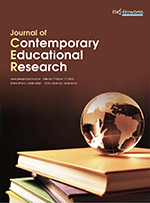Effectiveness of Mobile-Assisted Language Learning in Enhancing the English Proficiency
Abstract
In response to the significant impact of the widespread use of digital devices and mobile technologies on language teaching and learning in this time of Internet information technology, this study aims to investigate the effectiveness of Mobile-Assisted Language Learning (MALL) in enhancing the English proficiency of students, while exploring the potential advantages of mobile devices for assisted learning in the English learning environment in China and the potential for mobile applications to assist English learning to foster learner autonomy. Anchored with the design thinking approach, the researchers used the empirical analysis methodology in developing an efficient mobile-assisted language learning model. Usability testing was conducted using a case study of two mobile applications, WeLearn and Flipped English, in Heilongjiang University of Finance and Economics to measure the extent of usability and acceptability of MALL on English language acquisition among college students identified through surveys, interviews, and quantitative assessments. Mobile technology is a perfect tool for every student that enhances their experience and increases their joy while improving their English language skills. It adds new value and brings new opportunities for both English learners and the language education industry. Indeed, MALL is English learners’ new ally.
References
Isamiddinovna SF, 2019, Mobile Applications as a Modern Means of Learning English. Int. Conf. Inf. Sci. Commun. Technol. Appl. Trends Oppor. 2019 (ICISCT), 1–5. http://doi.org/10.1109/ICISCT47635.2019.9011897
Duman G, Orhon G, Gedik N, 2015, Research Trends in Mobile Assisted Language Learning from 2000 to 2012. ReCALL, 2015(2): 197–216.
Zhang Y, 2016, The Impact of Mobile Learning on ESL Listening Comprehension. DEStech Transactions on Social Science, Education and Human Science, (ICAEM). https://doi.org/10.12783/dtssehs/icaem2016/4290
Hazaea AN, 2018, Impact of Mobile Assisted Language Learning on Learner Autonomy in EFL Reading Context. Journal of Language and Education, 4(2): 48–58. https://doi.org/10.17323/2411-7390-2018-4-2-48-58
Abdulvahap S, Lütfiye G, Derya U, et al., 2018, A Review of Current Studies of Mobile Learning. Journal of EducationTechnology & Online Learning, 1(1): 13–27.
Lu Y, Xi P, 2013, The Study of Foreign Language Teaching Mode Based on the Mobile Learning Terminal. Modern Education Technology, 2013(6): 71–75.
Yao W, Fan J, 2017, Research on “4A + 4S” Mobile Micro-Learning Model of College English. Theory and Practice of Education, 2017(30): 56–58.
Jing Z, 2019, Research on User Acceptance of Mobile Language Learning Based on UTAUT2 Model. Technology Enhanced Foreign Language Education, 2019(6): 16–24.
Al-Rahmi AM, Al-Rahmi WM, Alturki U, et al., 2021, Exploring the Factors Affecting Mobile Learning for Sustainability in Higher Education. Sustainability 2021(13): 7893.
Song E, 2013, The Effects of TOEIC Study Using Smartphone TOEIC Applications on Learners’ TOEIC Scores and Perception at University Level. J. Korea Engl. Educ. Soc., 2013(12): 49–67.

